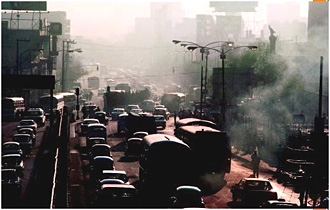
|  |  |  Health & Beauty | October 2008 Health & Beauty | October 2008  
Study: Smog Chops 2 Months Off Mexicans' Lives
 Alexandra Olson - Associated Press Alexandra Olson - Associated Press
go to original


| | The highest proportion of those deaths 38 percent were in Mexico City, a mountain-ringed valley long known for its dense layer of smog. | | |
Mexico City Mexicans would live an average of two months longer if they breathed cleaner air, Harvard researchers conclude in a study published Monday.

The study found that some 7,600 people's lives were cut short each year by diseases related to air pollution between 2001-2005, representing about 1.6 percent of annual deaths in Mexico.

The highest proportion of those deaths 38 percent were in Mexico City, a mountain-ringed valley long known for its dense layer of smog.

Mexico's average life expectancy 72.3 years for men and 77.8 for women would be longer by 2.4 months if urban air quality were improved, according to the study published in Proceedings of the National Academy of Sciences.

The researchers Gretchen Stevens, Rodrigo Dias and Majid Ezzati of the Harvard Initiative for Global Health used death records and air quality monitoring data to estimate the number of people who died from lung cancer, cardiopulmonary diseases, respiratory infections and other illnesses as a result of breathing heavily polluted air. Then they estimated what Mexico's average life expectancy rate would be if those people had not died early.

The researchers also studied the effect on mortality rates from the use of solid fuels, like coal and wood burning, and from unsafe water sanitation in Mexican homes.

From 2001 to 2005, about 3,000 people died each year from diseases related to using dirty water, while household fuels caused illnesses that killed 3,600. The study estimated that exposure to unsafe water sanitation shortened Mexico's average life expectancy by 1 month, while unclean fuels reduced it by 1.2 months.

The three factors combined killed 14,000 people a year, or 3 percent of total deaths in Mexico. Mexicans would live nearly five months longer if all three environmental problems were eliminated, the study found.

But the study found that while air pollution affected Mexicans of all income levels evenly, a disproportionate number of people in impoverished communities died from exposure to dirty household fuels and unsafe water.

The study found, for example, that improving water sanitation would reduce the child mortality rate by 6.2 percent in the poorest Mexican communities, but would have little effect in the wealthiest areas.

Worst affected were indigenous communities in the southern states of Chiapas, Guerrero and Oaxaca. Some 50 municipalities in those states had nearly 6 percent of overall deaths and 16 percent of child deaths from the three environmental risk factors, even though only 1.5 percent of Mexico's population lives there.

On the one hand in Mexico, air pollution is responsible for far more deaths than other environmental conditions, said Ezzati, an associate professor at Harvard School of Public Health. On the other hand, if you look at the poor parts of the country, there is a much bigger affect from not having clean water and not having clean fuel.

The study found that while air pollution affected mostly adults, unsafe water sanitation and dirty household fuels had a bigger impact on children.

The study noted that Mexico has rapidly reduced the number of households using dirty fuel and unclean water in the past two decades, and that its overall child mortality rate was on par with wealthier countries at 5.7 per 1,000.

Mexico has managed to be extremely impressive in reducing child mortality, Ezzati said. But there are pockets or areas remaining where these things are still happening. So what has been done extremely effectively nationally should be done in the remaining areas. |

 |
|  |



